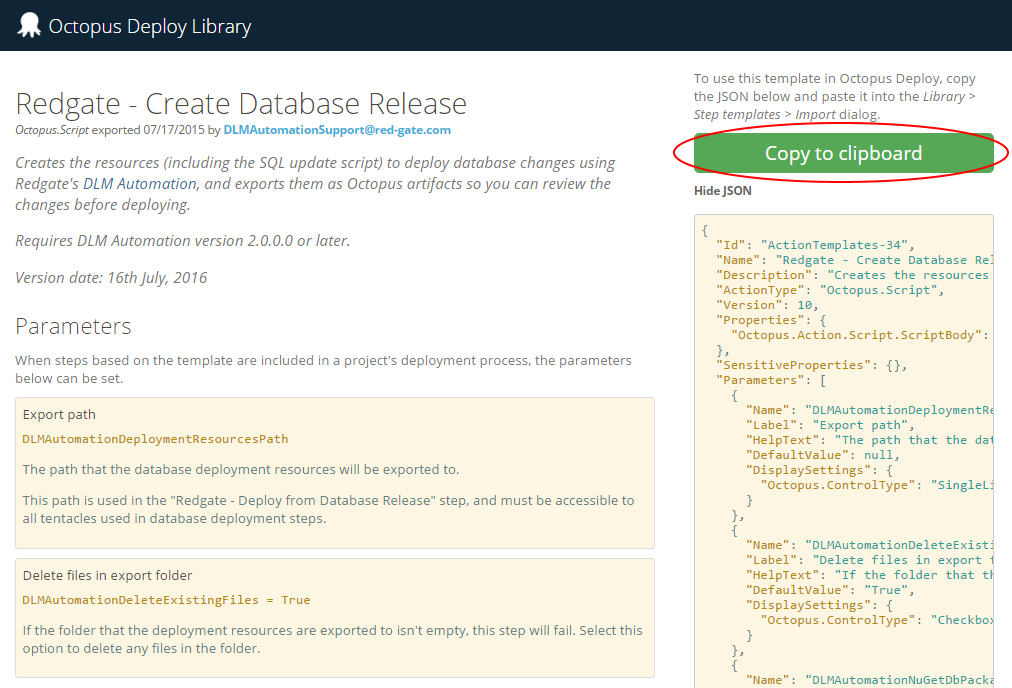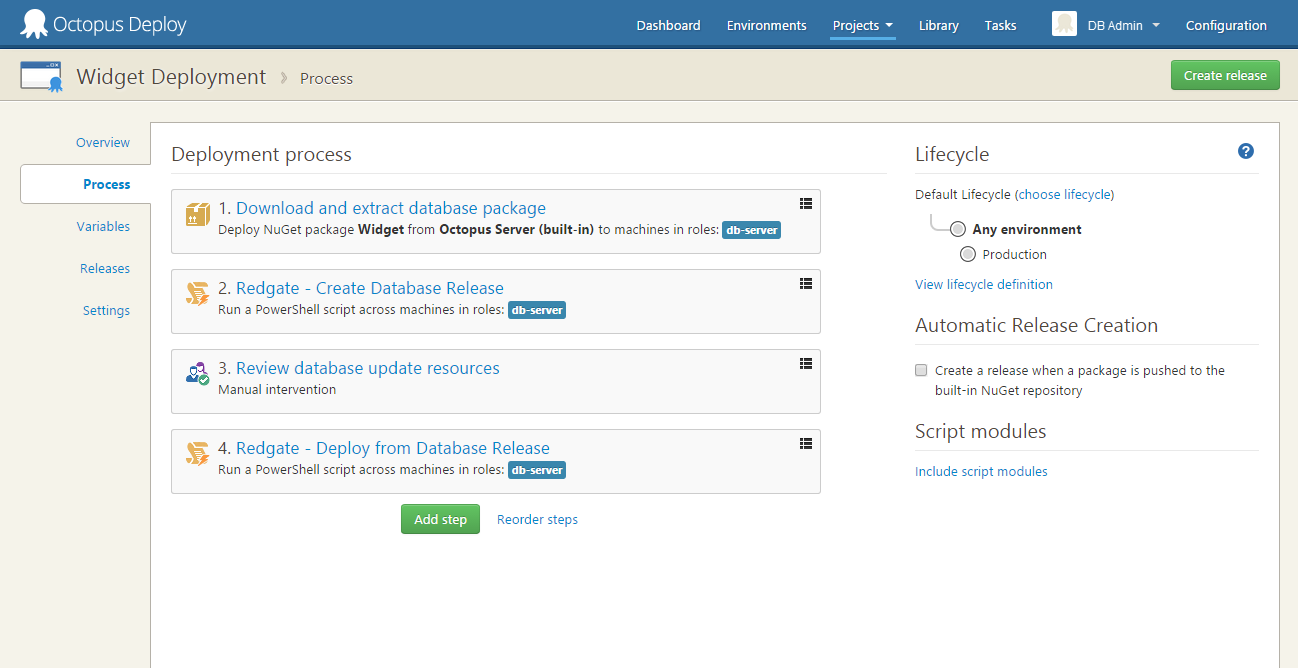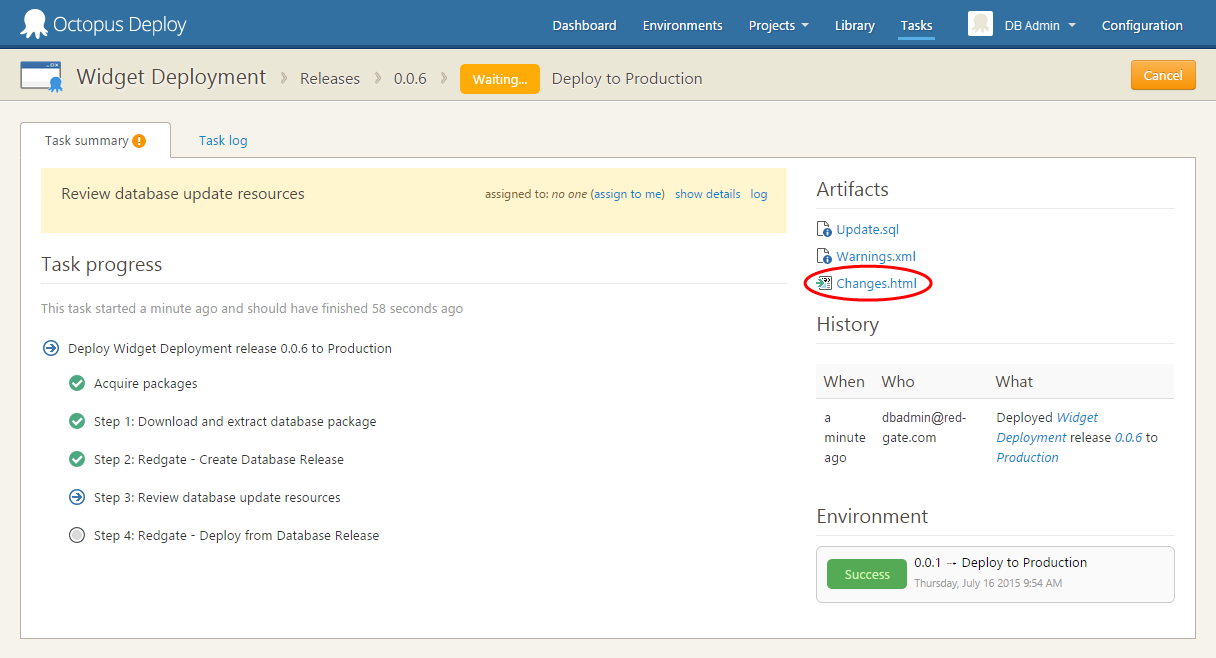Use the Octopus Deploy step templates
Published 10 March 2016
In this tutorial, you'll deploy a database from a NuGet package, using the DLM Automation step templates for Octopus Deploy.
Before you start
- Create a NuGet package containing a Redgate database scripts folder.
If you use DLM Automation for continuous integration, your build server can automatically build a package on every commit. See examples of how to do this using TeamCity or TFS. - Install DLM Automation. See Installing.n
- On the same machine, install Octopus Deploy. Click here for more details.
- Install an Octopus Tentacle and assign the db-server role. Click here for more details.
- Create an environment called Production, and add the machine running the Tentacle agent to it.
On this page
1. Copy the DLM Automation step templates to your Octopus Deploy library
After you've copied the DLM Automation step templates to your Octopus Deploy library, they're available whenever you add a process step in an Octopus Deploy project:
- Go to the DLM Automation step templates on the Octopus Deploy library website.
- In this example, we'll use the "Redgate - Create Database Release" and "Redgate - Deploy from Database Release" step templates.
Click on the "Redgate - Create Database Release" template. - Click Copy to clipboard:
You're now ready to paste the script from your clipboard into your Octopus Deploy library:
- In Octopus Deploy, at the top of the page, click Library.
- On the Step templates tab, click Import.
- In the Import window, paste the copied template into the empty field.
- Click Import.
- Click Save.
- Repeat steps 1 to 5 to copy the "Redgate - Deploy from Database Release" step template in the same way.
2. Create an Octopus Deploy project
- In Octopus Deploy, click Projects and All.
- Click Add project.
- In the Name field, enter Widget Deployment.
- Click Save.
You'll now add a series of deployment process steps to your Octopus Deploy project.
3. Add the "Download and extract database package" step
This step picks up the NuGet package of the database schema you're going to deploy.
- Set up your NuGet package feed by doing one of the following:
- register your existing external NuGet package feed with Octopus. For more details, see Adding external package feeds.
- configure your build server to push packages to the Octopus built-in repository. For more details, see Using the built-in repository.
- In the Widget Deployment project, on the Process tab, click Add step and select Deploy a NuGet package.
- In the Step name field, enter Download and extract database package.
- In the Machine roles field, enter db-server and press Enter.
This must match the role you assigned to the Tentacle. - In the NuGet feed field, select either the name of the external feed you registered when you set up your NuGet feed, or the Octopus Server (built-in) repository.
- In the NuGet package ID field, enter the name of the package without the version number. For example, if the package was called WidgetShopLatest.0.1.nupkg, you'd only enter Widget.
When the package is generated, NuGet package manager automatically adds a number. If we included it here, Octopus would only deploy the package that matched that name and version number. By removing the number, we're telling Octopus to always look for the latest package with that name. - In the Environments field, select Production.
If you leave this blank, the step will be accessible to all environments. - Click Save.
4. Add the "Create database release" step
This step creates the database deployment resources, including the Update.sql script.
- On the project Process tab, click Add step and Redgate - Create Database Release.
- In the Machine roles field, enter db-server and press Enter.
This must match the role you assigned to the Tentacle. - In the Export path field, enter the path the database deployment resources will be exported to.
This path will later be used in the "Deploy from Database Release" step. It must be accessible to all tentacles used in database deployment steps. - In the Database package step field, select Download and extract database package.
- In the Target SQL Server instance field, enter the fully qualified SQL Server instance for the database you're deploying to.
- In the Target database name field, enter the name of the database you're deploying to.
- In the Username (optional) and Password (optional) fields, enter the SQL Server username and password used to connect to the target database.
If you leave these blank, Windows authentication will be used to connect to the target database. - In the Environments field, select Production.
If you leave this blank, the step will be accessible to all environments. - Click Save.
5. Add the "Review database deployment resources" step
This step pauses deployment to let you review the database deployment resources, including the Changes.html report, before allowing deployment to go ahead.
- On the project Process tab, click Add step and select Manual intervention required.
- In the Step name field, enter Review database deployment resources.
In the Instructions field, copy and paste this text:
Please review the schema and static data changes, warnings and SQL change script in 'Changes.html'.
In the Environments field, select Production.
If you leave this blank, the step will be accessible to all environments.Click Save.
6. Add the "Deploy from database release" step
This step uses the database deployment resources to deploy the database changes.
- On the project Process tab, click Add step and select Redgate - Deploy from Database Release.
- In the Machine roles field, enter db-server and press Enter.
This must match the role you assigned to the Tentacle. - In the Export path field, enter the path the database deployment resources will be exported to.
This must match the export path you entered in 4. Add the 'Create database release' step. - In the Database package step field, select Download and extract database package.
- In the Target SQL Server instance field, enter the fully qualified SQL Server instance for the database you're deploying to.
- In the Target database name field, enter the name of the database you're deploying to.
- In the Username (optional) and Password (optional) fields, enter the SQL Server username and password used to connect to the target database.
If you leave these blank, Windows authentication will be used to connect to the target database. - In the Environments field, select Production.
If you leave this blank, the step will be accessible to all environments. - Click Save.
You've finished setting up the project steps. The Process tab should look like this:
7. Create a release
Now all the steps are set up, you can run your deployment process to create a release:
Create a blank database called WidgetProduction:
- Open SQL Server Management Studio (SSMS).
- Click New Query.
Execute the following SQL query to create the database:
CREATE DATABASE WidgetProduction GO USE WidgetProduction GO
- In the Widget Deployment project, on the Process tab, click Create release.
This page lets you add an optional release note. - Click Save.
- Click Deploy to Production (or if there's more than one environment, click Deploy and select Production).
- Click Deploy Now.
As the deployment process runs, Octopus Deploy shows the task progress list. The deployment pauses so you can review the database deployment resources:
- Click Changes.html to download the Change report.
Use the report to review the update script, warnings, and details of what'll be added, removed or modified if you go ahead with deployment. - In Octopus Deploy, click assign to me and, in Notes, enter a comment to say you've reviewed the database deployment resources.
- If you're happy with the report, click Proceed.
When the deployment is complete, the Task progress page looks like this:
You've now completed the deployment of the database package.
What now?
Other DLM Automation step templates are available on the Octopus Deploy Library website:
- "Redgate - Deploy from Database" deploys the schema of a source database to a target database without a review step.
- "Redgate - Deploy from Package" deploys a NuGet package containing a database schema to a target database without a review step.
For more information, see Octopus Deploy step templates reference.








